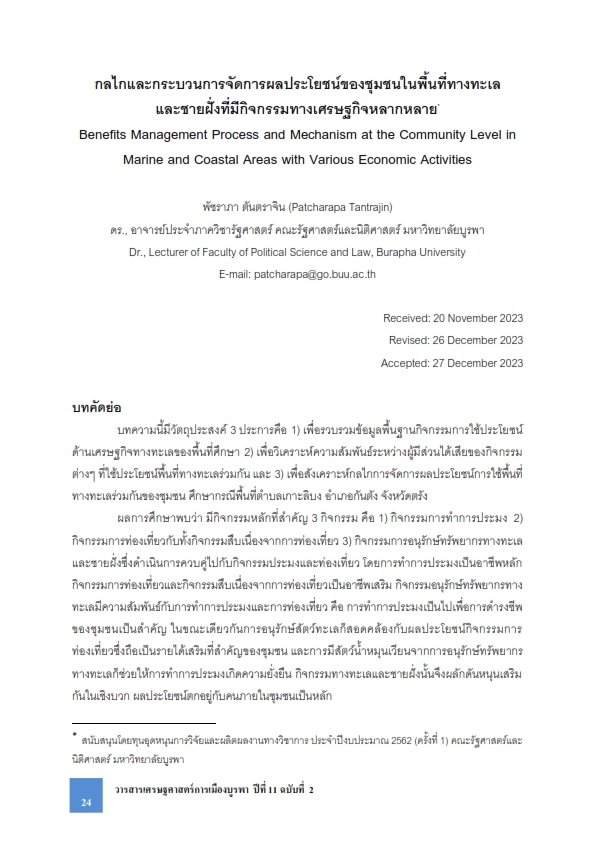Benefits Management Process and Mechanism at the Community Level in Marine and Coastal Areas with Various Economic Activities
Keywords:
Benefits Management Process at the Community level, Marine Economic Utilization, Community Natural Resources ManagementAbstract
This article aims to: 1) collect basic data on marine economic utilization in the study area. 2) analyze the relations between stakeholders utilizing and sharing the marine economy in the same area; and 3) synthesize co-mechanisms for managing marine profits in the study communities. The research area is KohLibong subdistrict, Kantang district, Trang province.
The research study found that there are three major activities.-- fishing, tourism, and activities related to tourism and coastal, and marine resource conservation -- that coincide and are related to one another. While fishing is the main occupation, tourism, and related activities are the additional ones. Also, activities on marine resource conservation are related to fishing and tourism as they help increase circulating marine animals and promote sustainable fishing. Moreover, conservation enhances tourism which has been an important source of income for the communities. Therefore, the marine and coastal activities help support one another positively and then the benefit will mainly belong to people in the communities.
There are three mechanisms in managing benefits: 1) community management led by the network based on the community’s regulations and leaders 2) co-management between state and communities such as zoning of marine use and 3) state management through laws such as fishing laws, and land usage laws in the reserved areas.
The main driving mechanism is community cooperation that has evolved from the past marine resource conservation activities. It is a mechanism that the state has not built, but it has come from the process built together in the communities with NGOs, coordinated, and worked as a network. This provides shared learning and reduces conflict between people in the communities. Later on, it was opened to the state to join in creating coordination between the state and the community in various activities.
References
รายการอ้างอิง
ภาษาไทย
เก็ตถวา บุญปราการ. (2541). การจัดการทรัพยากรธรรมชาติและสิ่งแวดล้อม ขององค์กรพัฒนาเอกชน
กรณีศึกษาสมาคมหยาดฝน จังหวัดตรัง. วิทยานิพนธ์วิทยาศาสตรมหาบัณฑิต สาขาการจัดการ
สิ่งแวดล้อม, มหาวิทยาลัยสงขลานครินทร์.
ทิพย์อุสา จันทกุน และคณะ. (2548). การจัดการท่องเที่ยวชุมชนที่สอดคล้องกับวิถีชีวิตของชาวเกาะลิบง
อำเภอกันตัง จังหวัดตรัง. รายงานวิจัย. กรุงเทพฯ: สำนักงานกองทุนสนับสนุนการวิจัย.
บัณฑูร เศรษฐศิโรตม์. (2558). ข้อเสนอต่อการบริหารจัดการทรัพยากรทางทะเลและชายฝั่ง. กรุงเทพฯ:
สำนักงานกองทุนสนับสนุนการวิจัย.
เผดิมศักดิ์ จารยะพันธุ์. (2553). โครงการจัดการความรู้เพื่อประโยชน์แห่งชาติทางทะเล. รายงาน
วิจัย. กรุงเทพฯ: สำนักงานกองทุนสนับสนุนการวิจัย.
มนัสศิริ ลูกรักษ์. (2543). ภูมิปัญญาท้องถิ่นในการทำประมงเพื่อการอนุรักษ์ทรัพยากรชายฝั่ง กรณีศึกษา
ชุมชนประมงพื้นบ้าน บ้านแหลมมะขาม ตำบลเขาไม้แก้ว อำเภอสิเกา จังหวัดตรัง. วิทยานิพนธ์
ศิลปศาสตรมหาบัณฑิต, สาขาวิชาการจัดการมนุษย์กับสิ่งแวดล้อม, มหาวิทยาลัยเชียงใหม่.
มานะ ช่วยชู และคณะ. (2538). วัฒนธรรมของชุมชนภาคใต้ในการใช้ทรัพยากรชายฝั่ง. รายงานวิจัย.
กรุงเทพฯ: สำนักงานคณะกรรมการวัฒนธรรมแห่งชาติ.
เรืองไร โตกฤษณะ, กุลภา กุลดิลก และกุลภา บุญชูวงศ์. (2558). การสร้างเสริมความสามารถของ
เกษตรกรผู้เพาะเลี้ยงสัตว์น้ำไทยเพื่อก้าวเข้าสู่การเป็นประชาคมเศรษฐกิจอาเซียน: สถานภาพ
และการมองไปข้างหน้า. วารสารการประมง, 68(6), 502-519.
สนิท อักษรแก้ว. (2542). ป่าชายเลน นิเวศวิทยาและการจัดการ. กรุงเทพฯ: สำนักพิมพ์
มหาวิทยาลัยเกษตรศาสตร์.
สร้อยสน รัฐสมบูรณ์. (2550). แนวทางการพัฒนาการท่องเที่ยวเชิงอนุรักษ์ ในพื้นที่ชุมชนเกาะลิบง
จังหวัดตรัง. วิทยานิพนธ์การวางแผนภาคและเมืองมหาบัณฑิต, สาขาวิชาการวางผังชุมชน,
คณะสถาปัตยกรรมศาสตร์, จุฬาลงกรณ์มหาวิทยาลัย.
สุวลักษณ์ สาธุมนัสพันธุ์. (2561). การจัดการชายฝั่ง: การบูรณาการสู่ความยั่งยืน. นครปฐม: สำนักพิมพ์
มหาวิทยาลัยมหิดล.
ภาษาอังกฤษ
Satumanatpan, S, Senawongse, P., Thansuporn. W., & Kirkman, H. (2014). Enhancing
Management Effectiveness of Environmental Protected Areas, Thailand. Ocean &
Coastal Management, 89, 1-10.
Websites
กรมทรัพยากรน้ำ กระทรวงทรัพยากรธรรมชาติและสิ่งแวดล้อม. (2556). พื้นที่ชุ่มน้ำ (Wetlands For Thai)
กรมทรัพยากรน้ำ. วันที่ค้นข้อมูล 10 ธันวาคม 2566. เข้าถึงได้จาก https://wetland.dwr.go.th/
wetlands/index.php/elementor-501/?fbclid=IwAR16kLyY4DfIm
nuj3iBPNkFxzq7oeEocv-hzrbIQsMXhl9OAKQgimQtpx0M.
ผู้จัดการออนไลน์. (2562). “เกาะลิบง” แหล่งหญ้าทะเลใหญ่ที่สุดในไทยมีมากถึง 11 ชนิด. วันที่ค้น
ข้อมูล 10 ธันวาคม 2566. เข้าถึงได้จาก https://mgronline.com/science/detail/9620000095005.
สัมภาษณ์
ชัยพฤกษ์ วีระวงศ์. (2563, 18 มิ.ย.). หัวหน้าเขตห้ามล่าสัตว์ป่า หมู่เกาะลิบง. สัมภาษณ์.
ณรงค์ คงเอียด. (2563, 19 มิ.ย.). หัวหน้าอุทยานแห่งชาติหาดเจ้าไหม. สัมภาษณ์.
ณัฐวัฒน์ ทะเลลึก. (2563, 5 ก.ค.). สัมภาษณ์.
เด่น ทะเลลึก. (2563, 5 ก.ค.). สัมภาษณ์.
มูฮัมหมัด ฟารุก. (2563, 30 ส.ค.). อดีตเจ้าหน้าที่มูลนิธิหยาดฝน. สัมภาษณ์.
หย่าเหตุ หะหวา. (2563, 5 ก.ค., 16 มิ.ย., 6 ธ.ค.). สัมภาษณ์.
อับดลรอหีม ขุนรักษา. (2563, 17 มิ.ย.). กำนันตำบลเกาะลิบง. สัมภาษณ์.
อาทร เหล็กเกิดผล. (2563, 16 มิ.ย.). สัมภาษณ์.
อิสมาแอน บินสะอาด. (2563, 5 ก.ค., 17 มิ.ย.). สัมภาษณ์.






